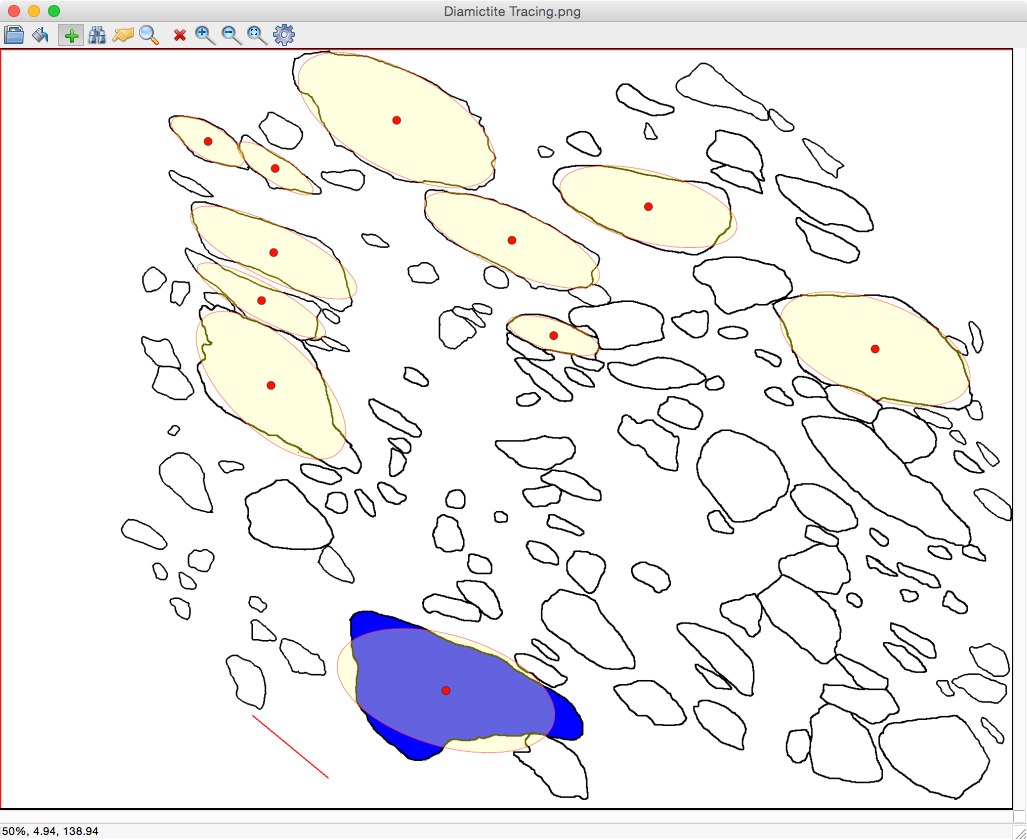
Downloads
EllipseFit
3.11.0
MacintoshMacintosh M1
Windows
Linux
User Manual
3.10.0
MacintoshMacintosh M1
Windows
Linux
3.9.1
MacintoshMacintosh M1
Windows
Linux
3.9.0
MacintoshMacintosh M1
Windows
Linux
Links
GitHubHome
Orient
Antevs
Donate
 EllipseFit is an integrated program for geologic fabric and finite strain analysis. It is used to derive two and three-dimensional strain from oriented photographs of thin sections, hand samples, or outcrop surfaces, and is designed for laboratory and field based structural geology studies. The intuitive graphical interface and multi-platform deployment also make it ideal for teaching introductory or advanced structural geology laboratories.
EllipseFit is an integrated program for geologic fabric and finite strain analysis. It is used to derive two and three-dimensional strain from oriented photographs of thin sections, hand samples, or outcrop surfaces, and is designed for laboratory and field based structural geology studies. The intuitive graphical interface and multi-platform deployment also make it ideal for teaching introductory or advanced structural geology laboratories.
 Images of oriented sections can be digitized using center-point, ellipse, shape, and filled shape methods. Shape fitting and filling, using moment ellipses, allows a wide range of geological objects to be analysed, including ooids, pebbles, fossils, and irregular clasts.
Images of oriented sections can be digitized using center-point, ellipse, shape, and filled shape methods. Shape fitting and filling, using moment ellipses, allows a wide range of geological objects to be analysed, including ooids, pebbles, fossils, and irregular clasts.
 Graphical strain analysis techniques include Fry plots, polar Elliott, Rf/Φ plots, strain maps, and polar and cylindrical hyperboloidal projections with automatic contouring.
Graphical strain analysis techniques include Fry plots, polar Elliott, Rf/Φ plots, strain maps, and polar and cylindrical hyperboloidal projections with automatic contouring.
Best-fit ellipse calculations include shape-matrix eigenvalue, mean radial length, and hyperboloidal vector mean. Shape-matrix error analysis is done analytically and using bootstrap techniques. The initial data set can be unstrained to check variation in the calculated pre-strain fabric.
 Fitting of ellipse-section data to a best-fit ellipsoid is done using the shape-matrix techniques of Robin and Shan. Error analysis is done by calculating the section ellipses, comparing the misfits between calculated and observed section ellipses, and by bootstrap statistics.
Fitting of ellipse-section data to a best-fit ellipsoid is done using the shape-matrix techniques of Robin and Shan. Error analysis is done by calculating the section ellipses, comparing the misfits between calculated and observed section ellipses, and by bootstrap statistics.
Graphical displays of ellipsoid data include Flinn, Ramsay, and Nadai-Hsu plots. Data can be directly digitized from photographs, or can be imported using comma delimited, tab delimited, Excel and LibreOffice spreadsheet files. Plots can be exported as bitmap images in various formats, or as vector graphics files which can be imported into graphics editing programs, such as Adobe Illustrator and Inkscape.
 Major functionalities include:
Major functionalities include:
- Digitizing points, quadrilaterals, ellipses, and shapes
- Fry-type analysis with void-fitting and error analysis
- Automated Wellman analysis for fossils
- Mean ellipse calculations with bootstrap confidence
- Contoured fabric plots including Rf/ϕ, Elliott polar, and equal-area
- Delaunay triangulation and strain maps
- Fabric data transformation and synthesis
- Flinn-Ramsay, Nadai-Hsu, and ellipsoid shade plots
- Robin and Shan ellipsoid calculations with error analysis
- Strain from displacements, strain probe, and stretch plots
 EllipseFit has been used for teaching strain analysis workshops with Paul Karabinos and Matty Mookerjee at the 2012 Structural Geology and Tectonics Forum, at Williams College, and the 2014 Structural Geology and Tectonics Forum, at the Colorado School of Mines. Newer versions contain numerous additional statistical procedures, tutorial exercises, bug fixes, and features.
EllipseFit has been used for teaching strain analysis workshops with Paul Karabinos and Matty Mookerjee at the 2012 Structural Geology and Tectonics Forum, at Williams College, and the 2014 Structural Geology and Tectonics Forum, at the Colorado School of Mines. Newer versions contain numerous additional statistical procedures, tutorial exercises, bug fixes, and features.
 For installation download the file for your operating system. For Windows installation, right click on the downloaded zip file, and select the Extract All option to extract the contents. The resulting folder will contain the EllipseFit application, the User Manual, and example files. You may move this folder anywhere you like, including to a thumb drive. For Macintosh, double click on the dmg file to open it, then drag EllipseFit to your Applications, or other, folder. The User Manual, and Example Files folder should also be copied to a directory of your choice. Right click on the application icon to start it for the first time, you may need to modify your Gatekeeper options before macOS will allow this. For Linux installation, right click on the tgz file, extract the contents, and copy the extracted ellipsefit application, User Manual, and Example Files folder to a directory of your choice.
For installation download the file for your operating system. For Windows installation, right click on the downloaded zip file, and select the Extract All option to extract the contents. The resulting folder will contain the EllipseFit application, the User Manual, and example files. You may move this folder anywhere you like, including to a thumb drive. For Macintosh, double click on the dmg file to open it, then drag EllipseFit to your Applications, or other, folder. The User Manual, and Example Files folder should also be copied to a directory of your choice. Right click on the application icon to start it for the first time, you may need to modify your Gatekeeper options before macOS will allow this. For Linux installation, right click on the tgz file, extract the contents, and copy the extracted ellipsefit application, User Manual, and Example Files folder to a directory of your choice.
EllipseFit is written by Frederick W. Vollmer and is free. Please read the accompanying User Manual for information on license, citation and references. EllipseFit is in active development, and user input, bug reports, and suggestions are greatly appreciated.

|

|

|
F.W. Vollmer GitHub
F.W. Vollmer Home
Software Home
Validated HTML 5
Updated 27 Nov 2022
F.W. Vollmer © 2011-2022